South Asia: Challenges of Democratic Peace and International Law
VerifiedAdded on 2023/04/11
|9
|1741
|399
Essay
AI Summary
This essay explores the application of democratic peace theory and international law in the South Asian region, focusing on countries like India, Pakistan, Bangladesh, Nepal, and Sri Lanka. It examines the prospects and challenges of establishing democratic peace in a region marked by historical conflicts, poverty, and nuclear risks. The essay highlights the importance of international law in maintaining regional stability, emphasizing principles such as non-interference and state sovereignty. It also addresses the role of international bodies like the United Nations and the impact of regional asymmetries, particularly the influence of India. The analysis considers the influence of political realism, human rights, trade, and maritime affairs in shaping South Asia's approach to international law, providing a comprehensive overview of the region's complex political and legal landscape. Desklib provides access to similar solved assignments and study resources for students.
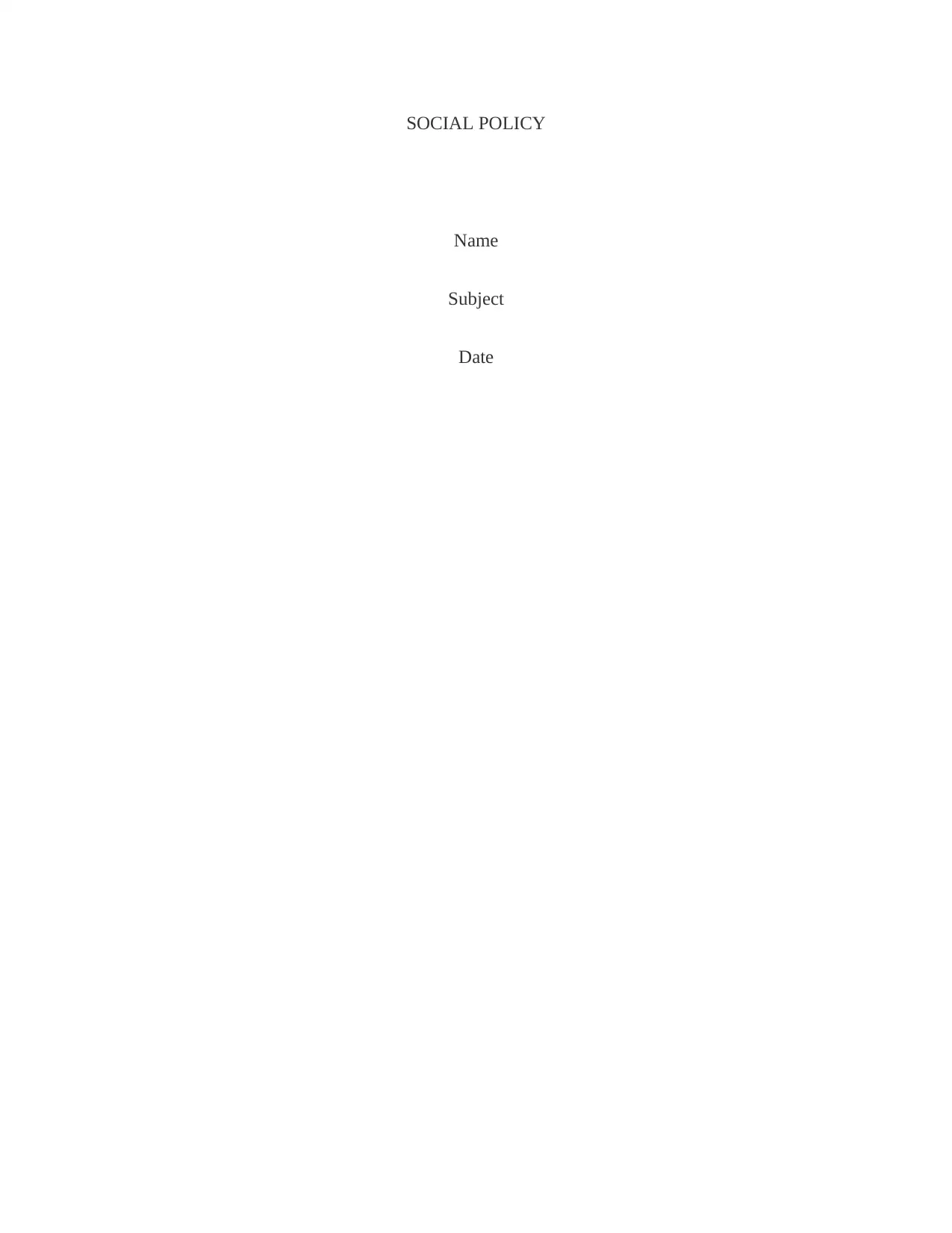
SOCIAL POLICY
Name
Subject
Date
Name
Subject
Date
Paraphrase This Document
Need a fresh take? Get an instant paraphrase of this document with our AI Paraphraser
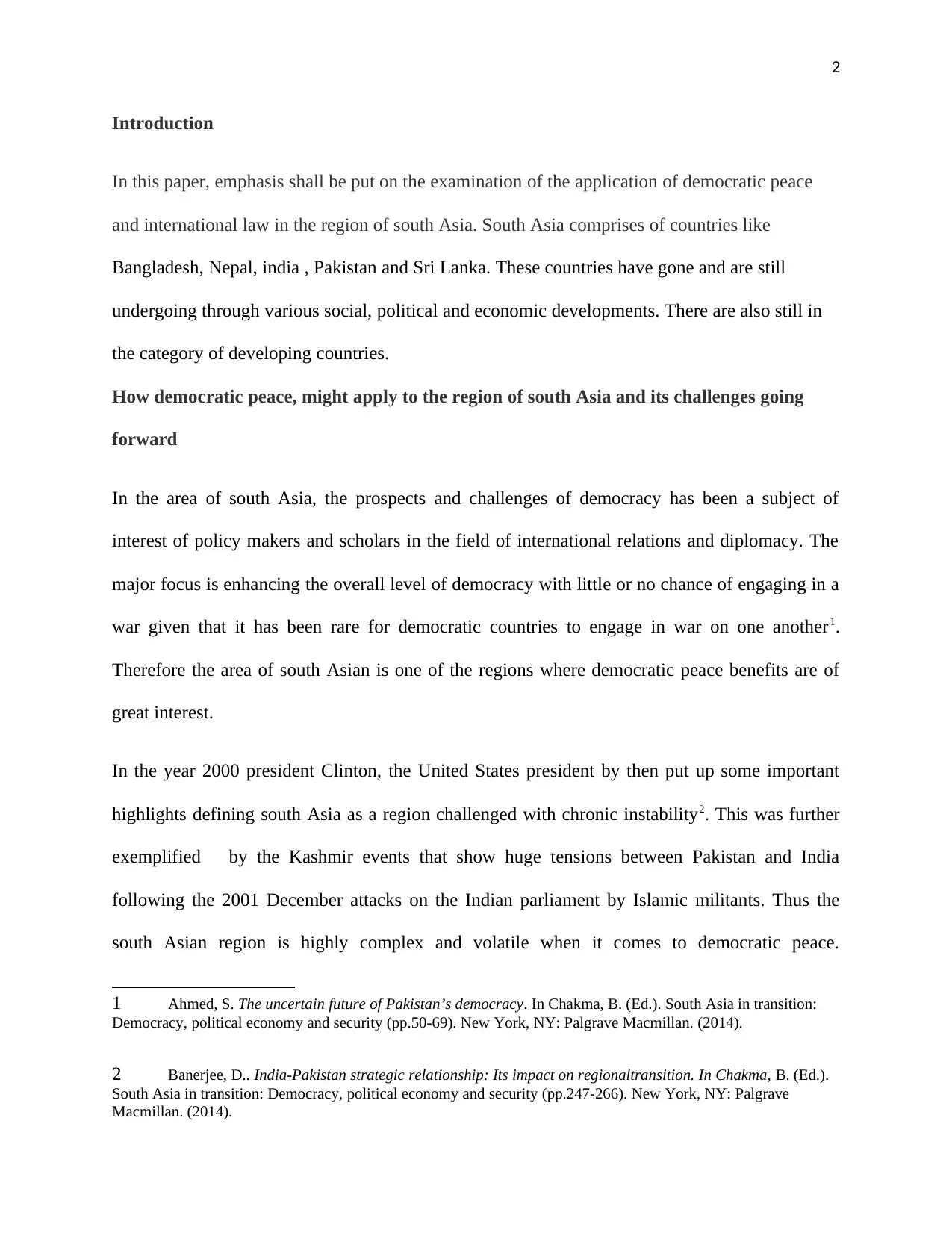
2
Introduction
In this paper, emphasis shall be put on the examination of the application of democratic peace
and international law in the region of south Asia. South Asia comprises of countries like
Bangladesh, Nepal, india , Pakistan and Sri Lanka. These countries have gone and are still
undergoing through various social, political and economic developments. There are also still in
the category of developing countries.
How democratic peace, might apply to the region of south Asia and its challenges going
forward
In the area of south Asia, the prospects and challenges of democracy has been a subject of
interest of policy makers and scholars in the field of international relations and diplomacy. The
major focus is enhancing the overall level of democracy with little or no chance of engaging in a
war given that it has been rare for democratic countries to engage in war on one another1.
Therefore the area of south Asian is one of the regions where democratic peace benefits are of
great interest.
In the year 2000 president Clinton, the United States president by then put up some important
highlights defining south Asia as a region challenged with chronic instability2. This was further
exemplified by the Kashmir events that show huge tensions between Pakistan and India
following the 2001 December attacks on the Indian parliament by Islamic militants. Thus the
south Asian region is highly complex and volatile when it comes to democratic peace.
1 Ahmed, S. The uncertain future of Pakistan’s democracy. In Chakma, B. (Ed.). South Asia in transition:
Democracy, political economy and security (pp.50-69). New York, NY: Palgrave Macmillan. (2014).
2 Banerjee, D.. India-Pakistan strategic relationship: Its impact on regionaltransition. In Chakma, B. (Ed.).
South Asia in transition: Democracy, political economy and security (pp.247-266). New York, NY: Palgrave
Macmillan. (2014).
Introduction
In this paper, emphasis shall be put on the examination of the application of democratic peace
and international law in the region of south Asia. South Asia comprises of countries like
Bangladesh, Nepal, india , Pakistan and Sri Lanka. These countries have gone and are still
undergoing through various social, political and economic developments. There are also still in
the category of developing countries.
How democratic peace, might apply to the region of south Asia and its challenges going
forward
In the area of south Asia, the prospects and challenges of democracy has been a subject of
interest of policy makers and scholars in the field of international relations and diplomacy. The
major focus is enhancing the overall level of democracy with little or no chance of engaging in a
war given that it has been rare for democratic countries to engage in war on one another1.
Therefore the area of south Asian is one of the regions where democratic peace benefits are of
great interest.
In the year 2000 president Clinton, the United States president by then put up some important
highlights defining south Asia as a region challenged with chronic instability2. This was further
exemplified by the Kashmir events that show huge tensions between Pakistan and India
following the 2001 December attacks on the Indian parliament by Islamic militants. Thus the
south Asian region is highly complex and volatile when it comes to democratic peace.
1 Ahmed, S. The uncertain future of Pakistan’s democracy. In Chakma, B. (Ed.). South Asia in transition:
Democracy, political economy and security (pp.50-69). New York, NY: Palgrave Macmillan. (2014).
2 Banerjee, D.. India-Pakistan strategic relationship: Its impact on regionaltransition. In Chakma, B. (Ed.).
South Asia in transition: Democracy, political economy and security (pp.247-266). New York, NY: Palgrave
Macmillan. (2014).
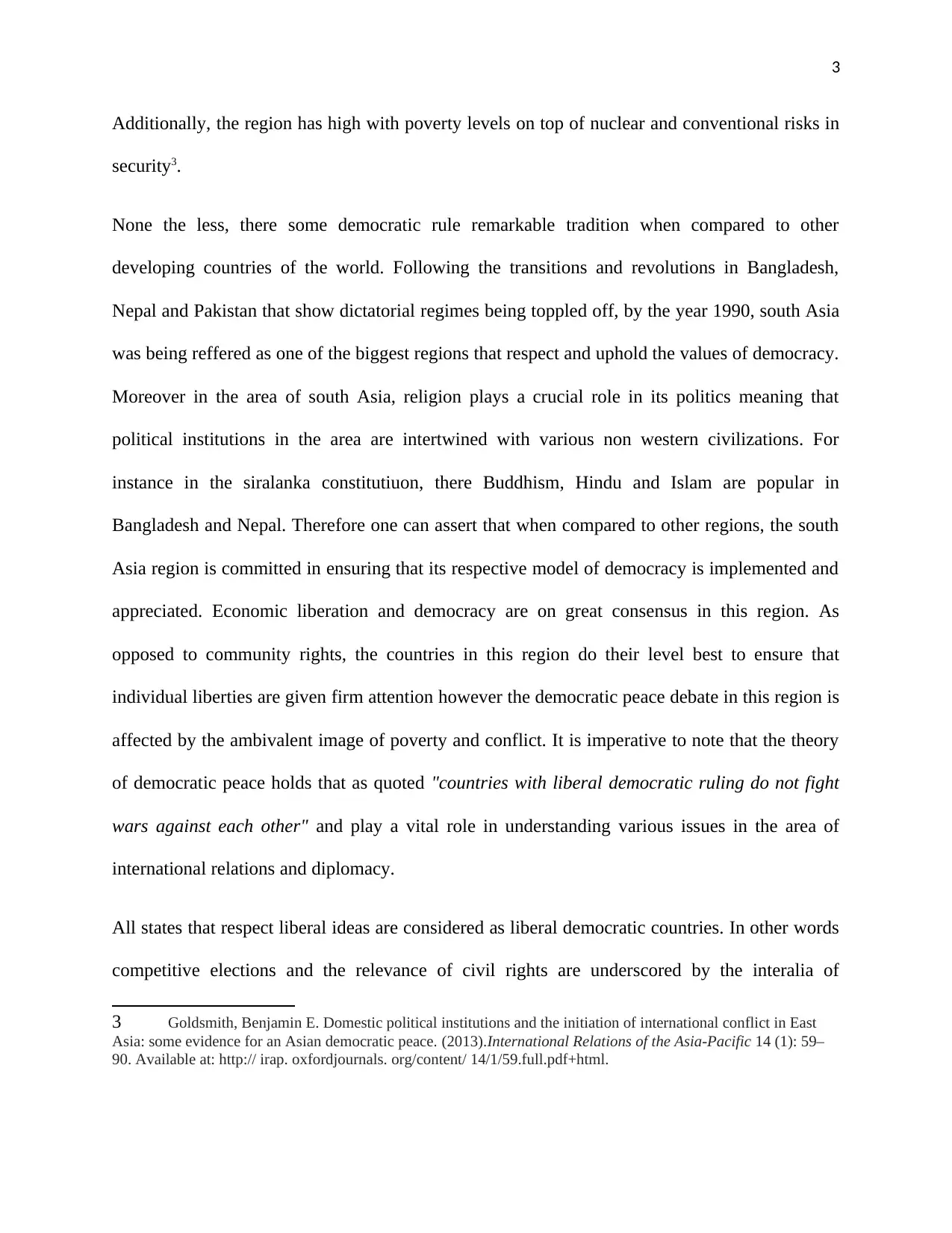
3
Additionally, the region has high with poverty levels on top of nuclear and conventional risks in
security3.
None the less, there some democratic rule remarkable tradition when compared to other
developing countries of the world. Following the transitions and revolutions in Bangladesh,
Nepal and Pakistan that show dictatorial regimes being toppled off, by the year 1990, south Asia
was being reffered as one of the biggest regions that respect and uphold the values of democracy.
Moreover in the area of south Asia, religion plays a crucial role in its politics meaning that
political institutions in the area are intertwined with various non western civilizations. For
instance in the siralanka constitutiuon, there Buddhism, Hindu and Islam are popular in
Bangladesh and Nepal. Therefore one can assert that when compared to other regions, the south
Asia region is committed in ensuring that its respective model of democracy is implemented and
appreciated. Economic liberation and democracy are on great consensus in this region. As
opposed to community rights, the countries in this region do their level best to ensure that
individual liberties are given firm attention however the democratic peace debate in this region is
affected by the ambivalent image of poverty and conflict. It is imperative to note that the theory
of democratic peace holds that as quoted "countries with liberal democratic ruling do not fight
wars against each other" and play a vital role in understanding various issues in the area of
international relations and diplomacy.
All states that respect liberal ideas are considered as liberal democratic countries. In other words
competitive elections and the relevance of civil rights are underscored by the interalia of
3 Goldsmith, Benjamin E. Domestic political institutions and the initiation of international conflict in East
Asia: some evidence for an Asian democratic peace. (2013).International Relations of the Asia-Pacific 14 (1): 59–
90. Available at: http:// irap. oxfordjournals. org/content/ 14/1/59.full.pdf+html.
Additionally, the region has high with poverty levels on top of nuclear and conventional risks in
security3.
None the less, there some democratic rule remarkable tradition when compared to other
developing countries of the world. Following the transitions and revolutions in Bangladesh,
Nepal and Pakistan that show dictatorial regimes being toppled off, by the year 1990, south Asia
was being reffered as one of the biggest regions that respect and uphold the values of democracy.
Moreover in the area of south Asia, religion plays a crucial role in its politics meaning that
political institutions in the area are intertwined with various non western civilizations. For
instance in the siralanka constitutiuon, there Buddhism, Hindu and Islam are popular in
Bangladesh and Nepal. Therefore one can assert that when compared to other regions, the south
Asia region is committed in ensuring that its respective model of democracy is implemented and
appreciated. Economic liberation and democracy are on great consensus in this region. As
opposed to community rights, the countries in this region do their level best to ensure that
individual liberties are given firm attention however the democratic peace debate in this region is
affected by the ambivalent image of poverty and conflict. It is imperative to note that the theory
of democratic peace holds that as quoted "countries with liberal democratic ruling do not fight
wars against each other" and play a vital role in understanding various issues in the area of
international relations and diplomacy.
All states that respect liberal ideas are considered as liberal democratic countries. In other words
competitive elections and the relevance of civil rights are underscored by the interalia of
3 Goldsmith, Benjamin E. Domestic political institutions and the initiation of international conflict in East
Asia: some evidence for an Asian democratic peace. (2013).International Relations of the Asia-Pacific 14 (1): 59–
90. Available at: http:// irap. oxfordjournals. org/content/ 14/1/59.full.pdf+html.
⊘ This is a preview!⊘
Do you want full access?
Subscribe today to unlock all pages.

Trusted by 1+ million students worldwide
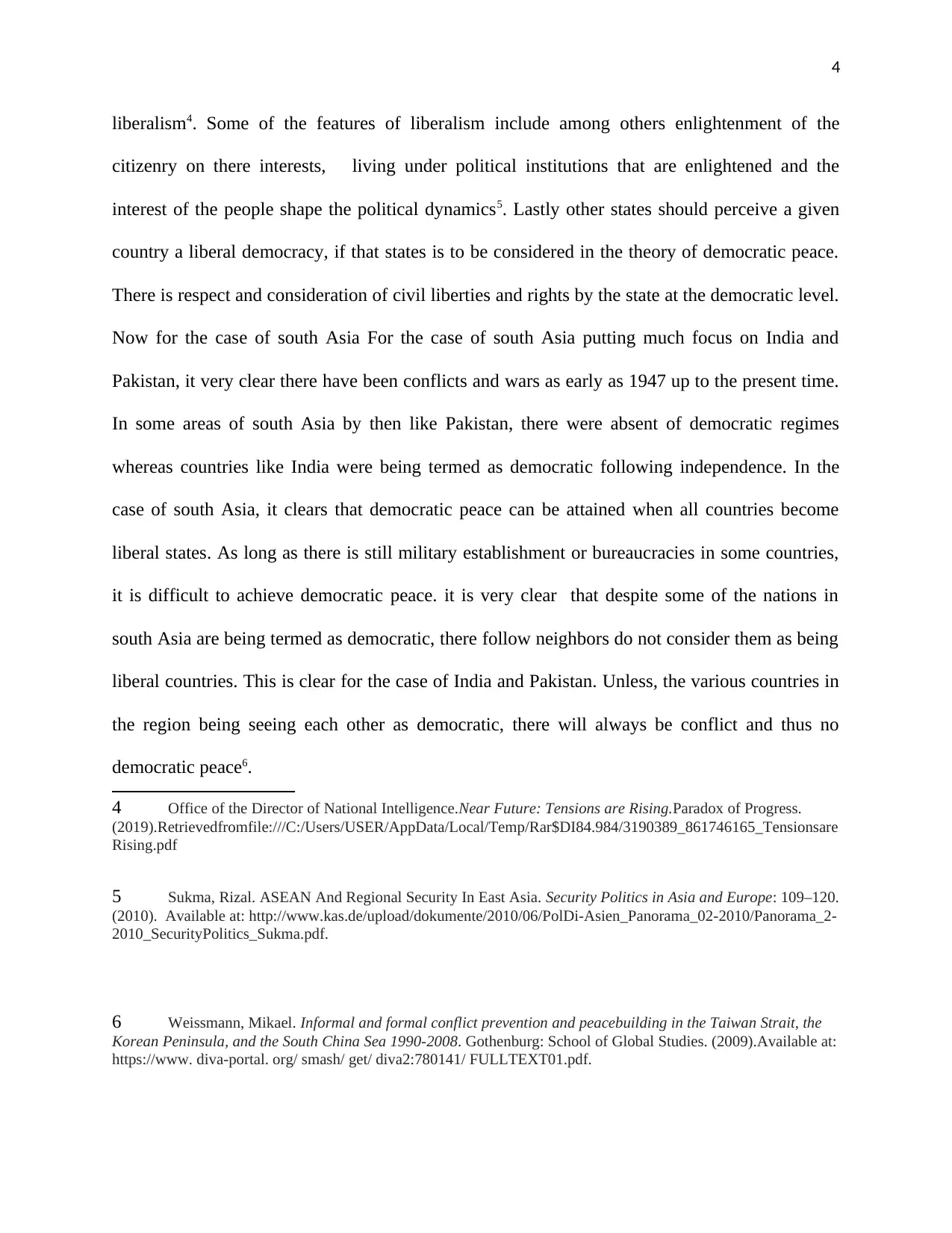
4
liberalism4. Some of the features of liberalism include among others enlightenment of the
citizenry on there interests, living under political institutions that are enlightened and the
interest of the people shape the political dynamics5. Lastly other states should perceive a given
country a liberal democracy, if that states is to be considered in the theory of democratic peace.
There is respect and consideration of civil liberties and rights by the state at the democratic level.
Now for the case of south Asia For the case of south Asia putting much focus on India and
Pakistan, it very clear there have been conflicts and wars as early as 1947 up to the present time.
In some areas of south Asia by then like Pakistan, there were absent of democratic regimes
whereas countries like India were being termed as democratic following independence. In the
case of south Asia, it clears that democratic peace can be attained when all countries become
liberal states. As long as there is still military establishment or bureaucracies in some countries,
it is difficult to achieve democratic peace. it is very clear that despite some of the nations in
south Asia are being termed as democratic, there follow neighbors do not consider them as being
liberal countries. This is clear for the case of India and Pakistan. Unless, the various countries in
the region being seeing each other as democratic, there will always be conflict and thus no
democratic peace6.
4 Office of the Director of National Intelligence.Near Future: Tensions are Rising.Paradox of Progress.
(2019).Retrievedfromfile:///C:/Users/USER/AppData/Local/Temp/Rar$DI84.984/3190389_861746165_Tensionsare
Rising.pdf
5 Sukma, Rizal. ASEAN And Regional Security In East Asia. Security Politics in Asia and Europe: 109–120.
(2010). Available at: http://www.kas.de/upload/dokumente/2010/06/PolDi-Asien_Panorama_02-2010/Panorama_2-
2010_SecurityPolitics_Sukma.pdf.
6 Weissmann, Mikael. Informal and formal conflict prevention and peacebuilding in the Taiwan Strait, the
Korean Peninsula, and the South China Sea 1990-2008. Gothenburg: School of Global Studies. (2009).Available at:
https://www. diva-portal. org/ smash/ get/ diva2:780141/ FULLTEXT01.pdf.
liberalism4. Some of the features of liberalism include among others enlightenment of the
citizenry on there interests, living under political institutions that are enlightened and the
interest of the people shape the political dynamics5. Lastly other states should perceive a given
country a liberal democracy, if that states is to be considered in the theory of democratic peace.
There is respect and consideration of civil liberties and rights by the state at the democratic level.
Now for the case of south Asia For the case of south Asia putting much focus on India and
Pakistan, it very clear there have been conflicts and wars as early as 1947 up to the present time.
In some areas of south Asia by then like Pakistan, there were absent of democratic regimes
whereas countries like India were being termed as democratic following independence. In the
case of south Asia, it clears that democratic peace can be attained when all countries become
liberal states. As long as there is still military establishment or bureaucracies in some countries,
it is difficult to achieve democratic peace. it is very clear that despite some of the nations in
south Asia are being termed as democratic, there follow neighbors do not consider them as being
liberal countries. This is clear for the case of India and Pakistan. Unless, the various countries in
the region being seeing each other as democratic, there will always be conflict and thus no
democratic peace6.
4 Office of the Director of National Intelligence.Near Future: Tensions are Rising.Paradox of Progress.
(2019).Retrievedfromfile:///C:/Users/USER/AppData/Local/Temp/Rar$DI84.984/3190389_861746165_Tensionsare
Rising.pdf
5 Sukma, Rizal. ASEAN And Regional Security In East Asia. Security Politics in Asia and Europe: 109–120.
(2010). Available at: http://www.kas.de/upload/dokumente/2010/06/PolDi-Asien_Panorama_02-2010/Panorama_2-
2010_SecurityPolitics_Sukma.pdf.
6 Weissmann, Mikael. Informal and formal conflict prevention and peacebuilding in the Taiwan Strait, the
Korean Peninsula, and the South China Sea 1990-2008. Gothenburg: School of Global Studies. (2009).Available at:
https://www. diva-portal. org/ smash/ get/ diva2:780141/ FULLTEXT01.pdf.
Paraphrase This Document
Need a fresh take? Get an instant paraphrase of this document with our AI Paraphraser
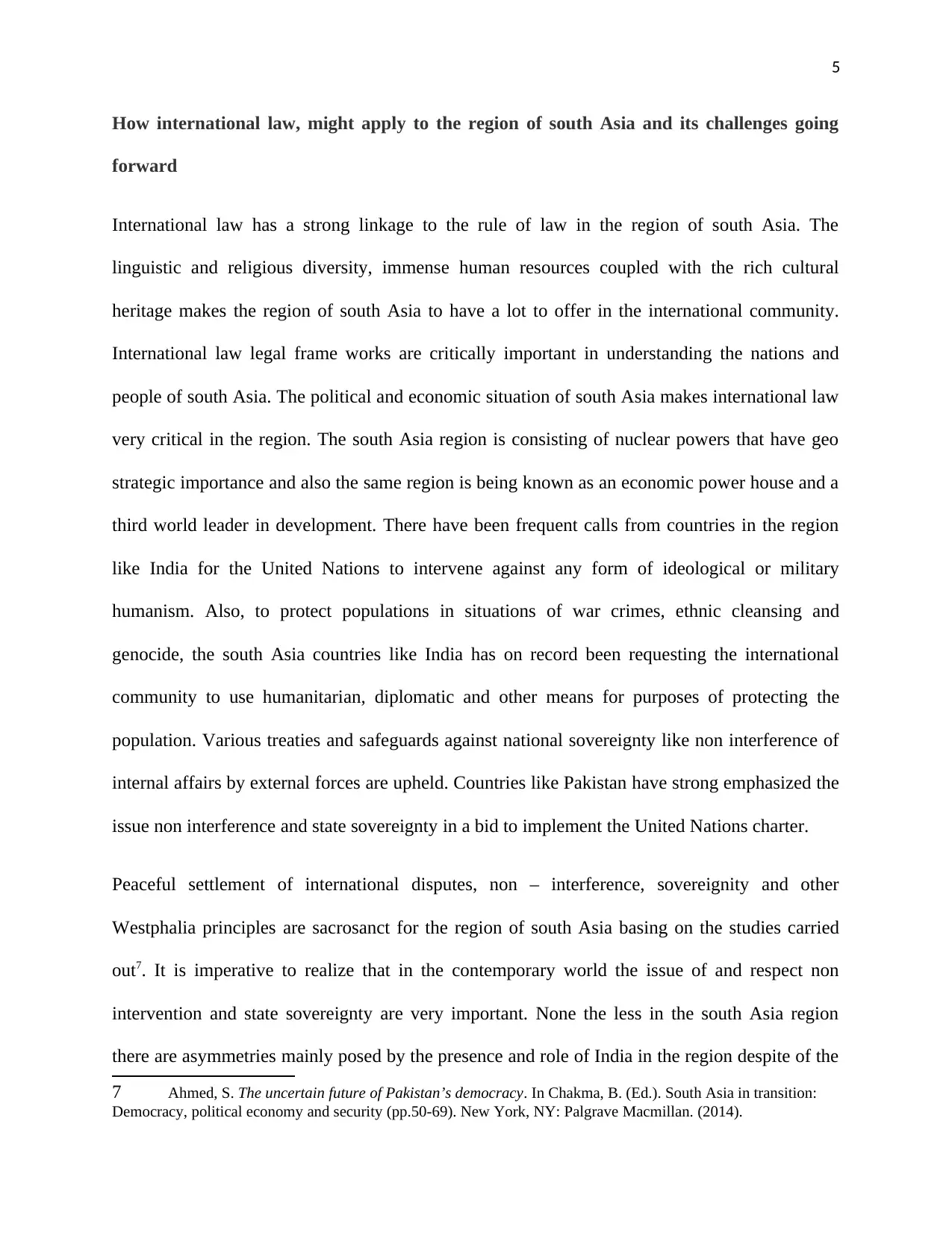
5
How international law, might apply to the region of south Asia and its challenges going
forward
International law has a strong linkage to the rule of law in the region of south Asia. The
linguistic and religious diversity, immense human resources coupled with the rich cultural
heritage makes the region of south Asia to have a lot to offer in the international community.
International law legal frame works are critically important in understanding the nations and
people of south Asia. The political and economic situation of south Asia makes international law
very critical in the region. The south Asia region is consisting of nuclear powers that have geo
strategic importance and also the same region is being known as an economic power house and a
third world leader in development. There have been frequent calls from countries in the region
like India for the United Nations to intervene against any form of ideological or military
humanism. Also, to protect populations in situations of war crimes, ethnic cleansing and
genocide, the south Asia countries like India has on record been requesting the international
community to use humanitarian, diplomatic and other means for purposes of protecting the
population. Various treaties and safeguards against national sovereignty like non interference of
internal affairs by external forces are upheld. Countries like Pakistan have strong emphasized the
issue non interference and state sovereignty in a bid to implement the United Nations charter.
Peaceful settlement of international disputes, non – interference, sovereignity and other
Westphalia principles are sacrosanct for the region of south Asia basing on the studies carried
out7. It is imperative to realize that in the contemporary world the issue of and respect non
intervention and state sovereignty are very important. None the less in the south Asia region
there are asymmetries mainly posed by the presence and role of India in the region despite of the
7 Ahmed, S. The uncertain future of Pakistan’s democracy. In Chakma, B. (Ed.). South Asia in transition:
Democracy, political economy and security (pp.50-69). New York, NY: Palgrave Macmillan. (2014).
How international law, might apply to the region of south Asia and its challenges going
forward
International law has a strong linkage to the rule of law in the region of south Asia. The
linguistic and religious diversity, immense human resources coupled with the rich cultural
heritage makes the region of south Asia to have a lot to offer in the international community.
International law legal frame works are critically important in understanding the nations and
people of south Asia. The political and economic situation of south Asia makes international law
very critical in the region. The south Asia region is consisting of nuclear powers that have geo
strategic importance and also the same region is being known as an economic power house and a
third world leader in development. There have been frequent calls from countries in the region
like India for the United Nations to intervene against any form of ideological or military
humanism. Also, to protect populations in situations of war crimes, ethnic cleansing and
genocide, the south Asia countries like India has on record been requesting the international
community to use humanitarian, diplomatic and other means for purposes of protecting the
population. Various treaties and safeguards against national sovereignty like non interference of
internal affairs by external forces are upheld. Countries like Pakistan have strong emphasized the
issue non interference and state sovereignty in a bid to implement the United Nations charter.
Peaceful settlement of international disputes, non – interference, sovereignity and other
Westphalia principles are sacrosanct for the region of south Asia basing on the studies carried
out7. It is imperative to realize that in the contemporary world the issue of and respect non
intervention and state sovereignty are very important. None the less in the south Asia region
there are asymmetries mainly posed by the presence and role of India in the region despite of the
7 Ahmed, S. The uncertain future of Pakistan’s democracy. In Chakma, B. (Ed.). South Asia in transition:
Democracy, political economy and security (pp.50-69). New York, NY: Palgrave Macmillan. (2014).
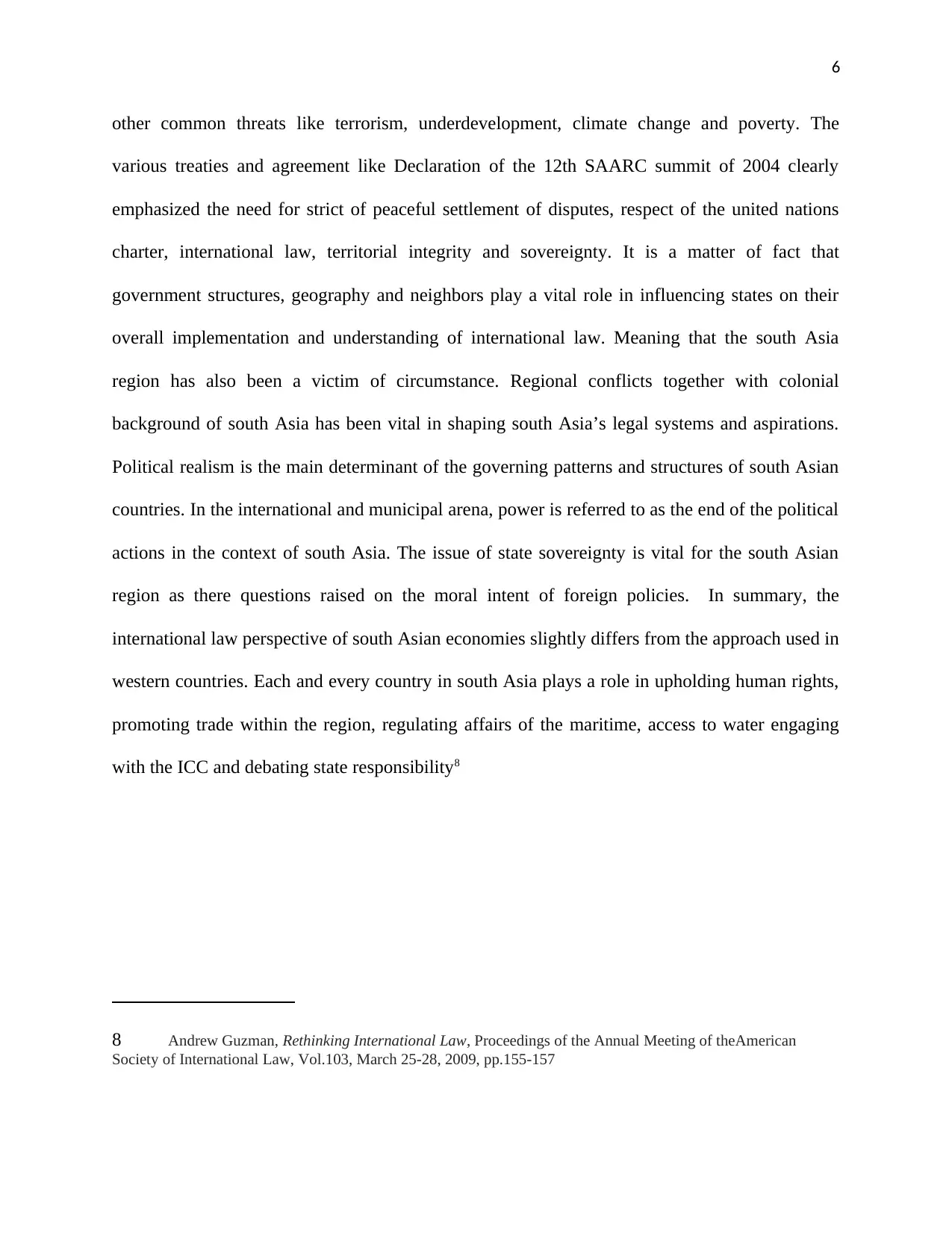
6
other common threats like terrorism, underdevelopment, climate change and poverty. The
various treaties and agreement like Declaration of the 12th SAARC summit of 2004 clearly
emphasized the need for strict of peaceful settlement of disputes, respect of the united nations
charter, international law, territorial integrity and sovereignty. It is a matter of fact that
government structures, geography and neighbors play a vital role in influencing states on their
overall implementation and understanding of international law. Meaning that the south Asia
region has also been a victim of circumstance. Regional conflicts together with colonial
background of south Asia has been vital in shaping south Asia’s legal systems and aspirations.
Political realism is the main determinant of the governing patterns and structures of south Asian
countries. In the international and municipal arena, power is referred to as the end of the political
actions in the context of south Asia. The issue of state sovereignty is vital for the south Asian
region as there questions raised on the moral intent of foreign policies. In summary, the
international law perspective of south Asian economies slightly differs from the approach used in
western countries. Each and every country in south Asia plays a role in upholding human rights,
promoting trade within the region, regulating affairs of the maritime, access to water engaging
with the ICC and debating state responsibility8
8 Andrew Guzman, Rethinking International Law, Proceedings of the Annual Meeting of theAmerican
Society of International Law, Vol.103, March 25-28, 2009, pp.155-157
other common threats like terrorism, underdevelopment, climate change and poverty. The
various treaties and agreement like Declaration of the 12th SAARC summit of 2004 clearly
emphasized the need for strict of peaceful settlement of disputes, respect of the united nations
charter, international law, territorial integrity and sovereignty. It is a matter of fact that
government structures, geography and neighbors play a vital role in influencing states on their
overall implementation and understanding of international law. Meaning that the south Asia
region has also been a victim of circumstance. Regional conflicts together with colonial
background of south Asia has been vital in shaping south Asia’s legal systems and aspirations.
Political realism is the main determinant of the governing patterns and structures of south Asian
countries. In the international and municipal arena, power is referred to as the end of the political
actions in the context of south Asia. The issue of state sovereignty is vital for the south Asian
region as there questions raised on the moral intent of foreign policies. In summary, the
international law perspective of south Asian economies slightly differs from the approach used in
western countries. Each and every country in south Asia plays a role in upholding human rights,
promoting trade within the region, regulating affairs of the maritime, access to water engaging
with the ICC and debating state responsibility8
8 Andrew Guzman, Rethinking International Law, Proceedings of the Annual Meeting of theAmerican
Society of International Law, Vol.103, March 25-28, 2009, pp.155-157
⊘ This is a preview!⊘
Do you want full access?
Subscribe today to unlock all pages.

Trusted by 1+ million students worldwide

7
Paraphrase This Document
Need a fresh take? Get an instant paraphrase of this document with our AI Paraphraser
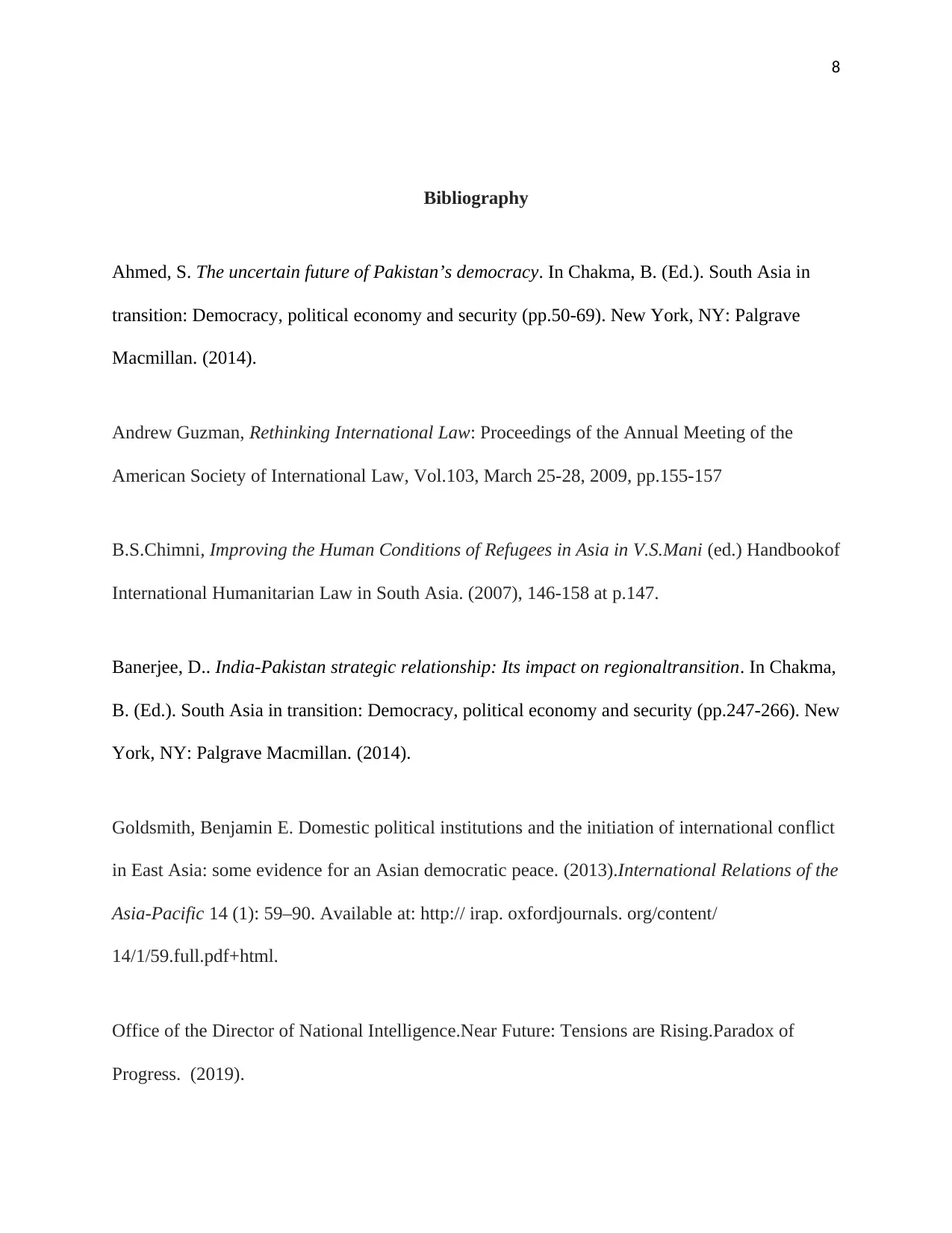
8
Bibliography
Ahmed, S. The uncertain future of Pakistan’s democracy. In Chakma, B. (Ed.). South Asia in
transition: Democracy, political economy and security (pp.50-69). New York, NY: Palgrave
Macmillan. (2014).
Andrew Guzman, Rethinking International Law: Proceedings of the Annual Meeting of the
American Society of International Law, Vol.103, March 25-28, 2009, pp.155-157
B.S.Chimni, Improving the Human Conditions of Refugees in Asia in V.S.Mani (ed.) Handbookof
International Humanitarian Law in South Asia. (2007), 146-158 at p.147.
Banerjee, D.. India-Pakistan strategic relationship: Its impact on regionaltransition. In Chakma,
B. (Ed.). South Asia in transition: Democracy, political economy and security (pp.247-266). New
York, NY: Palgrave Macmillan. (2014).
Goldsmith, Benjamin E. Domestic political institutions and the initiation of international conflict
in East Asia: some evidence for an Asian democratic peace. (2013).International Relations of the
Asia-Pacific 14 (1): 59–90. Available at: http:// irap. oxfordjournals. org/content/
14/1/59.full.pdf+html.
Office of the Director of National Intelligence.Near Future: Tensions are Rising.Paradox of
Progress. (2019).
Bibliography
Ahmed, S. The uncertain future of Pakistan’s democracy. In Chakma, B. (Ed.). South Asia in
transition: Democracy, political economy and security (pp.50-69). New York, NY: Palgrave
Macmillan. (2014).
Andrew Guzman, Rethinking International Law: Proceedings of the Annual Meeting of the
American Society of International Law, Vol.103, March 25-28, 2009, pp.155-157
B.S.Chimni, Improving the Human Conditions of Refugees in Asia in V.S.Mani (ed.) Handbookof
International Humanitarian Law in South Asia. (2007), 146-158 at p.147.
Banerjee, D.. India-Pakistan strategic relationship: Its impact on regionaltransition. In Chakma,
B. (Ed.). South Asia in transition: Democracy, political economy and security (pp.247-266). New
York, NY: Palgrave Macmillan. (2014).
Goldsmith, Benjamin E. Domestic political institutions and the initiation of international conflict
in East Asia: some evidence for an Asian democratic peace. (2013).International Relations of the
Asia-Pacific 14 (1): 59–90. Available at: http:// irap. oxfordjournals. org/content/
14/1/59.full.pdf+html.
Office of the Director of National Intelligence.Near Future: Tensions are Rising.Paradox of
Progress. (2019).
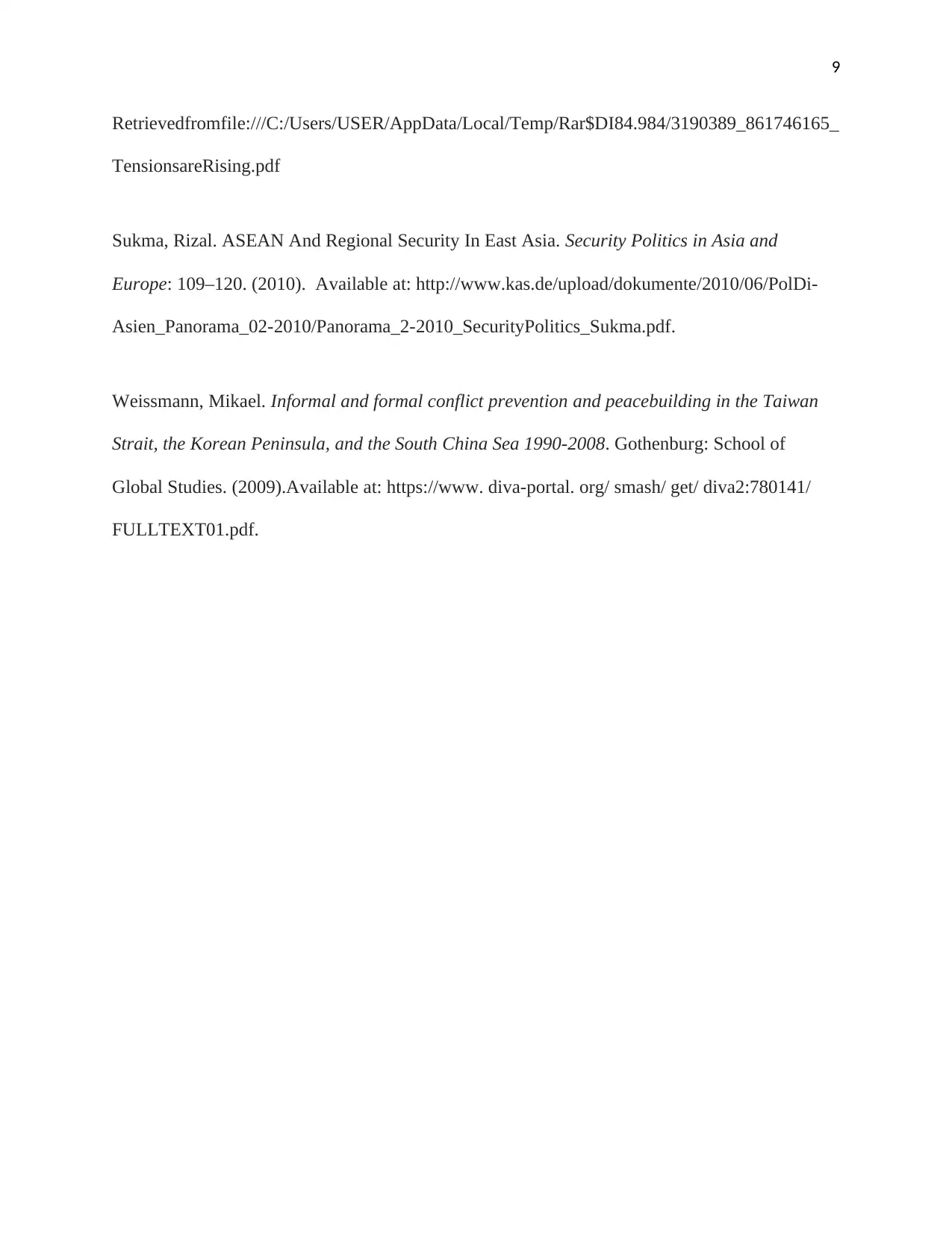
9
Retrievedfromfile:///C:/Users/USER/AppData/Local/Temp/Rar$DI84.984/3190389_861746165_
TensionsareRising.pdf
Sukma, Rizal. ASEAN And Regional Security In East Asia. Security Politics in Asia and
Europe: 109–120. (2010). Available at: http://www.kas.de/upload/dokumente/2010/06/PolDi-
Asien_Panorama_02-2010/Panorama_2-2010_SecurityPolitics_Sukma.pdf.
Weissmann, Mikael. Informal and formal conflict prevention and peacebuilding in the Taiwan
Strait, the Korean Peninsula, and the South China Sea 1990-2008. Gothenburg: School of
Global Studies. (2009).Available at: https://www. diva-portal. org/ smash/ get/ diva2:780141/
FULLTEXT01.pdf.
Retrievedfromfile:///C:/Users/USER/AppData/Local/Temp/Rar$DI84.984/3190389_861746165_
TensionsareRising.pdf
Sukma, Rizal. ASEAN And Regional Security In East Asia. Security Politics in Asia and
Europe: 109–120. (2010). Available at: http://www.kas.de/upload/dokumente/2010/06/PolDi-
Asien_Panorama_02-2010/Panorama_2-2010_SecurityPolitics_Sukma.pdf.
Weissmann, Mikael. Informal and formal conflict prevention and peacebuilding in the Taiwan
Strait, the Korean Peninsula, and the South China Sea 1990-2008. Gothenburg: School of
Global Studies. (2009).Available at: https://www. diva-portal. org/ smash/ get/ diva2:780141/
FULLTEXT01.pdf.
⊘ This is a preview!⊘
Do you want full access?
Subscribe today to unlock all pages.

Trusted by 1+ million students worldwide
1 out of 9
Related Documents
Your All-in-One AI-Powered Toolkit for Academic Success.
+13062052269
info@desklib.com
Available 24*7 on WhatsApp / Email
![[object Object]](/_next/static/media/star-bottom.7253800d.svg)
Unlock your academic potential
Copyright © 2020–2025 A2Z Services. All Rights Reserved. Developed and managed by ZUCOL.



